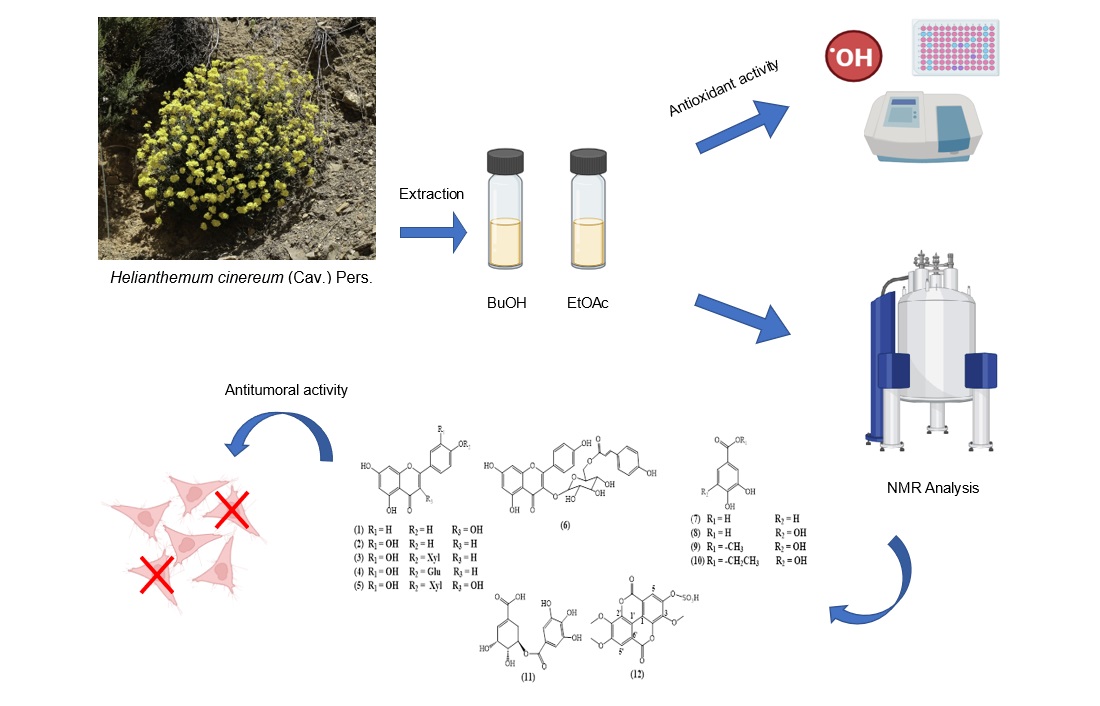Preprint
Article
Phytochemical Study and In Vitro Antioxidant Activity of Helianthemum cinereum Along with Antitumor Activity of the Isolated Trans-Tiliroside and Luteolin 4′-O-β-Xyloside
Altmetrics
Downloads
3
Views
5
Comments
0
Submitted:
15 November 2024
Posted:
19 November 2024
You are already at the latest version
Alerts
Abstract
Twelve compounds (1-12): kaempferol (1), luteolin (2), luteolin 4'-O-β-xyloside (3), luteolin 4'-O-β-glucoside (4), quercetin 4'-O-β-xyloside (5), kaempferol-3-O-[6"-O-(E)-p-coumaroyl]-β-D-glucoside (trans-tiliroside) (6), protocatechuic acid (7), gallic acid (8), methyl gallate (9), ethyl gallate (10), shikimic acid-3-O-gallate (11), and 3,3',4'-tri-O-methyl-ellagic acid 4-sulfate (12) were isolated and identified from the aerial parts of Helianthemum cinereum (Cav.) Pers (synonym: Helianthemum rubellum C. Presl. All compounds were isolated by applying different chromatographic procedures, such as silica gel, RP-18 and sephadex LH-20 columns. The structures were elucidated by extensive spectroscopic methods, mainly nuclear magnetic resonance NMR 1D and 2D, and mass spectrometry, as well as by comparison with the reported spectroscopic data. The two organic extracts, ethyl acetate (EtOAc) and butanol (BuOH) were evaluated for their potent phenolic and flavonoid contents using Folin-Ciocalteu and aluminum chloride colorimetric methods. Furthermore, the antioxidant activity of the two extracts was determined using the DPPH, FRAP, and ABTS methods. Pure trans-tiliroside (6), the main isolated compound, and luteolin 4'-O-β-xyloside (3) were evaluated for their antitumor activity against lung cancer (A549), melanoma (A375) and pancreatic cancer (Mia PaCa-2 and Panc-1) cell lines by MTT assay.

Keywords:
Subject: Biology and Life Sciences - Life Sciences
Copyright: This open access article is published under a Creative Commons CC BY 4.0 license, which permit the free download, distribution, and reuse, provided that the author and preprint are cited in any reuse.
Inula helenium subsp. Pseudohelenium: Phenolic Content, In Vitro Antimicrobial, Antioxidant, Antiproliferative, and DNA Protective Activities
Yusuf Alan
et al.
,
2023
Antiproliferative Activity of Stokesia laevis Ethanolic Extract in Combination with Several Food-Related Bioactive Compounds; In Vitro (CaCO2) And in Silico Docking (TNKS1) Studies
Georgeta Neagu
et al.
,
2021
Lignans from the Twigs of Litsea cubeba and Their Bioactivities
Xiuting Li
et al.
,
2018
MDPI Initiatives
Important Links
© 2024 MDPI (Basel, Switzerland) unless otherwise stated










